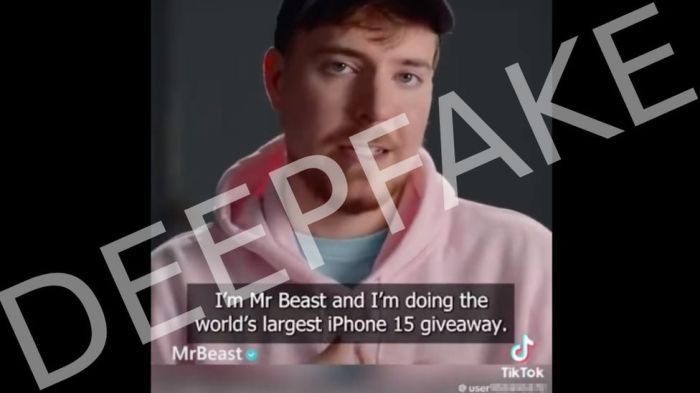How an AI deepfake ad of MrBeast ended up on TikTok is a question that has sparked curiosity and concern among digital natives. This viral incident, where a convincingly fake MrBeast ad appeared on the popular platform, highlights the growing power and potential pitfalls of AI deepfake technology in the advertising landscape. While the ad initially entertained viewers, it also raised questions about the authenticity of online content and the responsibility of social media platforms in regulating such deceptive practices.
The MrBeast deepfake ad serves as a stark reminder of the ethical challenges associated with AI deepfakes, particularly in advertising. With the ability to convincingly mimic real people, these deepfakes can be used to create misleading or even harmful content. This raises concerns about the potential for brands to exploit this technology for unethical marketing campaigns, potentially deceiving consumers and eroding trust in online advertising.
The Rise of AI Deepfakes
The emergence of AI deepfakes has ushered in a new era of digital manipulation, blurring the lines between reality and fabrication. These hyperrealistic videos, generated by sophisticated artificial intelligence algorithms, can convincingly mimic the appearance and voice of real individuals, raising profound ethical concerns.
Deepfakes are created using a technique called “deep learning,” a branch of artificial intelligence that involves training computer models on vast datasets of images and videos. These models learn to identify patterns and relationships within the data, enabling them to generate new content that closely resembles the original. In the case of deepfakes, the models are trained on images and videos of a specific individual, allowing them to generate synthetic versions of that person’s face, voice, and movements.
Ethical Implications of AI Deepfakes in Advertising
The potential for misuse of AI deepfakes in advertising is significant. Deepfakes could be used to create deceptive or misleading advertisements, featuring celebrities or public figures endorsing products or services without their consent. This could erode consumer trust and damage brand reputations. For example, a deepfake advertisement featuring a celebrity endorsing a product they have never actually used could mislead consumers into believing that the celebrity endorses the product.
Notable AI Deepfake Campaigns and Incidents
The rise of AI deepfakes has led to a number of notable campaigns and incidents.
- In 2019, a deepfake video of Barack Obama, created by BuzzFeed, went viral. The video, which appeared to show Obama making a speech criticizing Donald Trump, highlighted the potential for deepfakes to be used for political disinformation. The video was widely shared on social media and generated significant discussion about the ethical implications of deepfakes.
- In 2020, a deepfake video of Tom Hanks, created by a company called Deep Voodoo, was used in a Super Bowl commercial for Tide laundry detergent. The commercial, which featured Hanks singing a jingle about Tide, was well-received by viewers and helped to raise awareness of the potential of deepfakes in advertising.
MrBeast and TikTok: A Perfect Storm?
MrBeast’s presence on TikTok is undeniable, with millions of followers eagerly awaiting his next stunt or philanthropic endeavor. But how does his popularity on this platform translate into the potential impact of an AI deepfake ad? Let’s delve into the reasons behind MrBeast’s success on TikTok and explore the potential consequences of a deepfake ad featuring him.
MrBeast’s Popularity on TikTok
MrBeast’s success on TikTok stems from a perfect blend of factors. He understands the platform’s unique dynamics, leveraging its short-form video format to deliver engaging content that resonates with his target audience. His content often features a combination of high-stakes challenges, elaborate stunts, and charitable endeavors, creating a captivating blend of entertainment and social responsibility. This formula has proven highly effective in attracting a massive following, particularly among younger generations. MrBeast’s target audience on TikTok aligns with the platform’s demographics, with a significant portion of his followers falling within the 13-24 age range. This demographic is known for its high engagement with social media and its susceptibility to viral trends, making TikTok a fertile ground for MrBeast’s content to flourish.
Potential Impact of a Deepfake Ad Featuring MrBeast
The potential impact of a deepfake ad featuring MrBeast on TikTok is a complex issue. While the ad might initially garner significant attention due to its novelty and the inherent intrigue of seeing a deepfake, it could also have unintended consequences. The authenticity of a deepfake ad is inherently compromised, as it relies on manipulating existing footage to create a fabricated representation. This lack of authenticity could erode trust in MrBeast and his brand, potentially leading to negative repercussions. Furthermore, the use of deepfakes raises ethical concerns about consent and the potential for misuse. If a deepfake ad were to be used without MrBeast’s knowledge or consent, it could be considered a violation of his privacy and intellectual property rights.
Comparing the Authenticity of a Deepfake Ad to a Traditional MrBeast Advertisement
The authenticity of a deepfake ad stands in stark contrast to a traditional MrBeast advertisement. Traditional advertisements feature MrBeast’s genuine presence, showcasing his personality and brand values. These ads are typically produced with his direct involvement, ensuring alignment with his image and message. Deepfake ads, on the other hand, rely on artificially generated representations, creating a sense of detachment and potentially undermining the credibility of the advertisement. While deepfake technology has advanced significantly, it remains difficult to replicate the nuanced expressions and authentic persona that characterize MrBeast’s presence in his genuine advertisements.
The Viral Nature of the Ad: How An Ai Deepfake Ad Of Mrbeast Ended Up On Tiktok
The deepfake MrBeast ad quickly gained traction on TikTok, becoming a viral sensation. Its spread can be attributed to a confluence of factors, including the platform’s unique algorithm, the inherent novelty of the deepfake technology, and the strong brand recognition associated with MrBeast.
The ad’s virality was fueled by several key factors.
The Power of TikTok’s Algorithm
TikTok’s algorithm is designed to prioritize content that is engaging and likely to resonate with users. The deepfake ad, with its unexpected twist and uncanny resemblance to MrBeast, perfectly captured the attention of viewers. The algorithm, recognizing this high engagement, amplified the ad’s reach, pushing it to a wider audience.
The Novelty of Deepfake Technology
The use of deepfake technology in the ad itself was a major driver of virality. Deepfakes, with their ability to convincingly manipulate images and videos, are still relatively new and generate significant curiosity and interest. The ad, showcasing this technology in a playful and entertaining way, further heightened the public’s fascination with deepfakes.
MrBeast’s Brand Recognition
MrBeast, as a popular and influential figure on YouTube and other social media platforms, already enjoys a vast and engaged following. The deepfake ad, leveraging his brand recognition, instantly resonated with his fans, who were eager to share and discuss the ad with their own networks. This network effect further amplified the ad’s reach and contributed to its viral spread.
User Reactions and Engagement
The ad sparked a wave of user engagement on TikTok. Users reacted with a mix of amusement, disbelief, and curiosity. Many were quick to share the ad with friends and followers, further fueling its viral spread. The comments section of the ad was filled with discussions about the deepfake technology, MrBeast’s involvement, and the ad’s overall impact.
Potential for Further Content and Discussion
The deepfake MrBeast ad has the potential to generate further content and discussion on TikTok and other platforms. The ad’s unexpected nature and its implications for the future of advertising are likely to continue to be debated. It could also inspire other creators to experiment with deepfake technology in their own content, leading to a wave of innovative and potentially controversial creations.
Implications for the Future of Advertising
The MrBeast deepfake ad on TikTok showcased the immense potential of AI deepfakes to disrupt the advertising industry. It demonstrated how this technology can create hyper-realistic and engaging content, blurring the lines between reality and fiction, and opening up new avenues for brands to connect with audiences.
The Potential for Disruption, How an ai deepfake ad of mrbeast ended up on tiktok
The rise of AI deepfakes has the potential to revolutionize the advertising industry in several ways. It can create immersive and interactive experiences, personalize content, and enhance brand storytelling.
- Immersive Experiences: AI deepfakes can be used to create virtual worlds and interactive experiences that allow users to interact with brands and products in a completely new way. Imagine an ad where users can virtually walk through a store, try on clothes, or even interact with a celebrity spokesperson using a deepfake.
- Personalized Content: AI deepfakes can be used to create personalized content that caters to individual preferences and interests. This could involve generating ads featuring specific individuals, tailoring product recommendations, or creating personalized experiences based on user data.
- Enhanced Storytelling: AI deepfakes can be used to enhance storytelling in advertising campaigns. Brands can use deepfakes to bring historical figures to life, recreate past events, or create fictional scenarios that resonate with audiences. This can help brands create more engaging and memorable campaigns.
Hypothetical Scenario: Deepfakes in Future Advertising Campaigns
Imagine a future where brands use AI deepfakes to create personalized and interactive shopping experiences. For example, a clothing brand could create a virtual store using deepfake technology. Customers could virtually walk through the store, try on clothes, and receive personalized styling advice from a deepfake of a renowned fashion stylist. The experience would be interactive, engaging, and tailored to each customer’s preferences. This would create a more immersive and personalized shopping experience, leading to increased customer engagement and brand loyalty.
Challenges and Opportunities
The use of AI deepfakes in advertising presents both challenges and opportunities for brands and advertisers.
- Ethical Concerns: The use of deepfakes raises ethical concerns about consent, privacy, and the potential for manipulation. Brands need to be mindful of these concerns and ensure that their use of deepfakes is ethical and responsible.
- Transparency and Disclosure: It is crucial for brands to be transparent about their use of deepfakes and to clearly disclose when they are using this technology. This builds trust with consumers and avoids any potential deception or confusion.
- Regulation and Legal Issues: The legal landscape surrounding AI deepfakes is still evolving. Brands need to stay informed about regulations and legal implications to ensure compliance and avoid any legal repercussions.
- Technical Challenges: The development and implementation of AI deepfakes require significant technical expertise and resources. Brands need to invest in the necessary technology and infrastructure to effectively utilize this technology in their advertising campaigns.
The MrBeast deepfake ad incident is a powerful illustration of the evolving landscape of online content and the challenges we face in navigating a world where the line between reality and fabrication is increasingly blurred. As AI technology continues to advance, it’s crucial for social media platforms, advertisers, and consumers alike to work together to establish clear guidelines and safeguards to prevent the misuse of deepfakes and ensure the integrity of online information. This incident serves as a reminder that we must remain vigilant in critically evaluating the content we encounter online, questioning its authenticity, and holding those responsible for creating and distributing misleading content accountable.
Remember that AI deepfake ad of MrBeast that popped up on TikTok? It was wild, right? Turns out, the tech behind that kind of stuff is getting some serious attention. Bfree, a company focused on using AI for good, just secured some fresh backing bfree gets fresh backing which means we might see even more creative (and maybe even more realistic) AI-powered content popping up soon.
Who knows, maybe MrBeast will even be in on it next time!
 Standi Techno News
Standi Techno News

